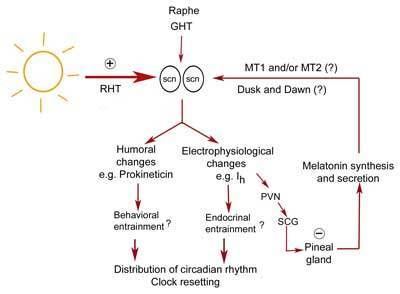Symbol MTNR1A HUGO 7463 RefSeq NM_005958 | Entrez 4543 OMIM 600665 UniProt P48039 | |
 | ||
Melatonin receptors
A melatonin receptor is a G protein-coupled receptor (GPCR) which binds melatonin.
Contents
- Melatonin receptors
- Melatonin receptor agonists
- Expression patterns
- MT1
- MT2
- MT3
- Agonists
- Antagonists
- References
Three types of melatonin receptor have been cloned. The MT1 (or Mel1A or MTNR1A) and MT2 (or Mel1B or MTNR1B) receptor subtypes are present in humans and other mammals, while an additional melatonin receptor subtype MT3 (or Mel1C or MTNR1C) has been identified in amphibia and birds.
Melatonin receptor agonists
Expression patterns
In mammals, melatonin receptors are found in the brain and some peripheral organs. However, there is considerable variation in the density and location of MT receptor expression between species.
MT1
In humans, The MT1 subtype is expressed in the pars tuberalis of the pituitary gland and the suprachiasmatic nuclei of the hypothalamus.
MT2
The MT2 subtype is expressed in the retina. MT2 receptor mRNA has not been detected by in situ hybridization in the rat suprachiasmatic nucleus or pars tuberalis.
MT3
The MT3 subtype of many non-mammalian vertebrates is expressed in various brain areas.
MT1
In humans, The MT1 subtype's expression in the pars tuberalis of the pituitary gland and suprachiasmatic nuclei of the hypothalamus is indicative of melatonin's circadian and reproductive functional involvement.
MT2
In humans, the MT2 subtype's expression in the retina is suggestive of melatonin's effect on the mammalian retina occurring through this receptor. Research suggests that melatonin acts to inhibit the Ca2+-dependent release of dopamine. Melatonin's action in the retina is believed to affect several light-dependent functions, including phagocytosis and photopigment disc shedding.
